|
This scenic "Mountain Peaks & Glaciers" driving tour offers travelers an in-depth look at Alaska's most beautiful national parks. The 11-day vacation includes a spectacular flight over Wrangell-St. Elias National Park, an adventurous drive on the legendary McCarthy Road from the historic ghost town of Kennicott / McCarthy to Chitina, a drive through the Matanuska Valley - Alaska's fertile farmland with an immense number of summer sunshine hours where vegetables grow to incredible sizes (the cabbage record is 106 pounds), the opportunity to see the "the Big Five" species of Denali NationalPark - wolves, caribou, Dall sheep, moose and bears, and finally the goldrush town of Fairbanks which is the gateway to Alaska's Arctic region. |
AK#07 Mountain Peaks & Glaciers | Alaska's Scenic National Parks
Tour Itinerary
Dates | Rates
Options | Extensions
Accommodation
Rental Car
Self Drive FAQ
|
Day
01 |
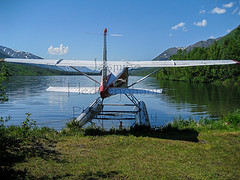 |
Anchorage Upon arrival in Anchorage, pick up your rental car at the airport or downtown. Get ready for an unforgettable Alaska vacation. Anchorage features dozens of parks and 122 miles of paved bike paths. Warmed by a maritime climate, you can spend the day with salmon fishing on downtown's Ship Creek, hiking the nearby mountains, photographing glaciers and dining at a four-star restaurant. Within a 15-minute drive from downtown on the Hillside is the tree-lined trailhead of Anchorage’s most popular hike, Flattop Mountain. A short floatplane ride opens up the possibility of almost any type adventure. That’s one reason why Anchorage’s Lake Hood is the world’s busiest floatplane base. Try some fresh Alaska seafood (Salmon, Halibut and Dungeness Crab) for dinner in one of the many excellent restaurants around the hotel. Afterwards enjoy a stroll along the coastal trail with sweeping views of Mt. Denali and Mt. Susitna aka: the "Sleeping Lady". Overnight: Anchorage |
|
Day
02 |
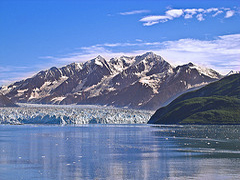 |
Anchorage | Prince William Sound 26-Glacier Cruise This morning take the scenic Seward Highway along Turnagain Arm to the glacier studded Portage (Lake) Valley. To access the remote community of Whittier, you will travel through North America's longest shared rail - and vehicle tunnel. The Prince William Sound is one of the few places left in the world where a concentration of glaciers can be found in such abundance. On the 26 Glacier Cruise (Tour Included), you will explore the serenity of Esther Passage, view the majestic alpine and tidewater glaciers within College and Harriman Fjords covered with ancient ice, observe a large variety of marine wildlife and travel in luxurious comfort aboard the Klondike Express - the fastest catamaran in Alaska. Your captain and the US Forest Service ranger will point out the sites along the way. Watch for playful sea otters, harbor seals, kittiwakes, bears, whales or mountain goats. Return to Anchorage with a stopover at Portage Lake Visitor Center and at the Alyeska Ski Resort. Overnight: Anchorage |
|
Day
03 |
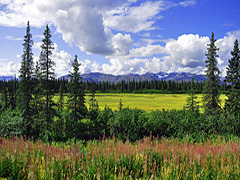 |
Anchorage - Matanuska Valley - Chitina - Flight to Kennicott / McCarthy Travel towards the Matanuska Valley - a fertile farmland that was settled by families as part of a New Deal relief program in 1935. Because of the fertile farmland and the immense amount of summer sunlight, vegetables grow to incredible sizes. The Alaska record cabbage is 106 pounds! This is just one of the attractions at the State Fair held in Palmer. The Matanuska Glacier is one of Alaska's most accessible glaciers, a 27-mile long river of ice poking out of the Chugach Mountains that is visible for miles along the highway. A self-guided hike leads to the gravel-laced ice. Arrive in Chitina from where you will take a scenic flightseeing trip (Included) to McCarthy (departures 2:45 pm & 5:45 pm), heart of the Wrangell/St. Elias National Park. You will see the Kennicott Glacier as it winds its way 25 miles to the North where it tumbles off the South East face of Mt. Blackburn. The Root and Gates Glaciers flow from ridges of Mt. Regal to join the Kennicott forming one of the most spectacular vistas in the park. Travel Distance: 200 Miles + Flight. |
|
Day
04 |
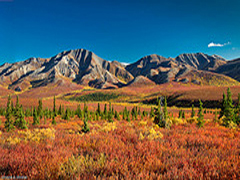 |
McCarthy | Kennicott (Wrangell - St. Elias National Park) In recent years, the Wrangell St. Elias National Park Service has restored most of the mine buildings, and tours of the huge mill building, bunkhouses, a train depot and worker's cottages are available.Visit the Kennicott Mine with it's white-trimmed red buildings that stand out against the dramatic mountain-and-glacier backdrop at the actual mine site. The entire area is for sure a photographer’s dream. Get ready today for a 1/2 day Root Glacier Hike (optional). The hike is most likely the best day hiking trip in Alaska, and almost certainly the best glacier hiking in Alaska! After meeting your guide and getting fitted for crampons, you'll start out on the 1.8 mile hike to the "white ice" of the Root. Along the way your guide will share interesting details on the local natural and human history. Once on the ice you will explore other-worldly formations unlike anything else you have ever seen: blue pools, waterfalls, canyons, crevasses and moulin holes drilled hundreds of feet deep into the ice by the flowing meltwater. |
|
Day
05 |
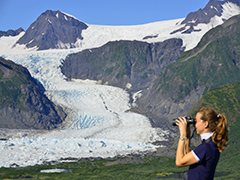 |
McCarthy | Kennicott - Flight to Chitina, Copper Center Spend this morning to explore the area of Kennicott & McCarthy. The mine was abandoned in 1938 but many of the historic buildings still stand as they were on that last day, leaving a living history of those rugged days of high adventure. Many of the buildings are also open for the public to explore during the day. Wrangell-St. Elias is truly a wilderness park offering great opportunities for alpine hiking, rafting or flightseeing. Return to Chitina by bushplane - or optional - onboard a comfortable passenger van on the 60-mile McCarthy Road. Follow the path of the Copper River & Northwestern Railway, nicknamed 'Can't Run and Never Will'. You will stop at the Kuskulana River, which is a 525' steel bridge built in 1911 that spans a 283 ft. gorge, and at the Gilahina River railroad wooden trestle. Your scenic flight or van transfer ends in Chitina where you left your car. See fishwheels turning while crossing the Copper River bridge, home of the famous Copper River Red Salmon. Your tour ends in Chitina. Overnight: Copper Center |
|
Day
06 |
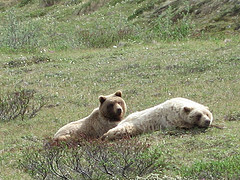 |
Copper Center - Fairbanks Leave Copper Center on the Richardson Highway. Known as a paradise for anglers and rafters searching for big fish and whitewater adventure, Gakona, Copper Center and Glenallen are great jump-off points during the famed Copper River Red Salmon runs (Sockeye). For trout and grayling as well as salmon, try the Gulkana River, which is also nearby. Continue to Paxson with it's many sled dog kennels and further on to Delta Junction - a telegraph station established in 1904. The intersection, marked by an oversized white milepost for Mile 1422 of the Alaska - and Richardson Highway, is known as the Triangle. Delta Junction is also home to the 90,000-acre Delta Bison Sanctuary, which was created to contain a free-roaming herd of more than 500 animals. The area features spectacular views of the Alaska Range and the Delta River. On clear days the panoramas of Mount Hayes, Mount Moffit and other peaks are stunning. Travel Distance: 260 Miles | Overnight: Fairbanks |
|
Day
07 |
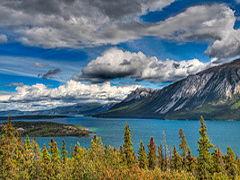 |
Fairbanks In 1902, Felix Pedro found gold in the region and thousands of prospectors swarmed to the area in search of the “Mother lode.” Nearly a century later, Fairbanks is the trade and transportation center for Interior and Far North Alaska. From mid-May through July, visitors can enjoy more than 20 hours of sunlight a day. Today you have the unique chance to cross the Arctic Circle and to visit the vast interior. Join us on a guided van tour along the Dalton Highway to the Arctic Circle. En-route enjoy stunning views of the interior and the Trans-Alaska-Pipeline, put your hand in the Yukon River, travel through the wetlands and crest the high plateau of Finger Mountain looking out for wildlife. You can also join a bush mail plane flight and experience how the Gwich'in Athabascan Natives live in "Bush" Alaska. Another option is to drive along Chena Hot Springs road, go on a hiking trip and visit Chena Hot Springs Resort. Here you can relax in the large natural outdoor rock lake and visit the Aurora Ice Museum. |
|
Day
08 |
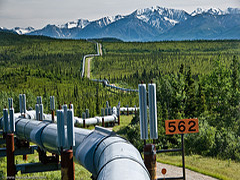 |
Fairbanks - Denali National Park Fairbanks, known as the Golden Heart City of Alaska, is the gateway to the interior and features almost 24 hours of daylight during the summer months. You are invited to explore the local gold rush history, its vibrant traditional native cultures as well as its abundant wildlife and fantastic scenery. Tucked into miles of unexplored wilderness only 120 miles from the Arctic Circle, Fairbanks offers excellent year-round outdoor recreational opportunities. This morning you may visit the renown Alaska University Museum featuring Alaska's natural history best collection, Alaskaland or take an authentic sternwheeler on a scenic 20-mile roundtrip cruise down the Chena and Tanana Rivers. Enjoy lively narration, stop at a reconstructed Athabascan Indian Village to learn about native hunting and fishing techniques and watch a dogsled demonstration. Leisurely drive to Nenana - known for it's Alaska Ice Classics - to Denali National Park. Distance: 110 Miles | Overnight: Denali National Park |
|
Day
09 |
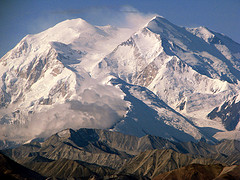 |
Denali National Park Early departure (pre-reserved time & seating) for a full day Denali National Park and wildlife observation tour within the shadows of 20.320 ft Mt. Denali (formerly Mt. McKinley) to Eielson Visitor Center or scenic Wonder Lake with a immense (best) view of “ the Mountain”. Tour Included ! Watch for Grizzly Bears, Moose, Caribou, Wolf and Fox along the ridges and river beds or observe one of the 150 different bird species which inherit the park area. This trip offers some great hiking opportunities too. Return to the national park entrance anytime at your own pace. Optional: Upgrade to the narrated Tundra Wilderness Tour or the Kantishna Roadhouse Adventure. This is a full day narrated tour along the Park Road to the Kantishna Roadhouse. This trip covers the entire length of the restricted 95-mile Denali Park Road to Kantishna in a private bus. A trained naturalist provides natural history interpretation and assists in search for wildlife while pointing out the regional biology and geology. A lunch at Kantishna Roadhouse is included. |
|
Day
10 |
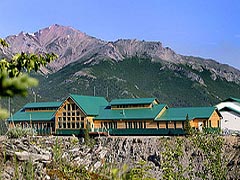 |
Denali National Park - Talkeetna Denali National Park and Preserve was created 1980 from the former Mt McKinley National Park. At over 6 million acres, the park is larger than the State of Massachusetts. It exemplifies interior Alaska’s character as one of the world’s last great frontiers for wilderness adventure and it remains largely wild and unspoiled, as the Athabascan knew it. Enjoy sweeping views of snowcapped mountain peaks in the distance while traveling on the George Parks Highway south towards Talkeetna. Tip: Stopover within Denali State Park for some wildlife viewing, a canoe rental on Byers Lake and excellent hiking opportunities. Denali, the “Great One”, is the name Athabascan people gave the massive peak that crowns the 600-mile long Alaska Range. Distance 150 Miles | Overnight: Talkeetna |
|
Day
11 |
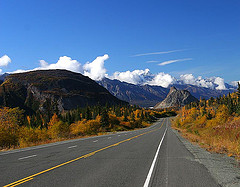 |
Talkeetna - Anchorage This morning you have the opportunity to join a flightseeing trip within 6-Miles of Mt. Denali's 20.320 ft summit and get a picture perfect view of the Kahiltna and Ruth Glacier with its Great Gorge - over 9.000 ft deep - as well as onto magnificent ice-falls. See the Sheldon Amphitheatre and add on a glacier landing at the base of Mt. Denali. Experience the excitement of standing among the great peaks - the immense scale will astound you. Continue via Wasilla (Iditarod Museum) to Anchorage. Your self drive tour ends today with the rental car drop off at the Anchorage Airport. Optional program extensions are available. Please contact us. Distance 115 Miles |
| Rates in US $ / per Person | Single | Double | Triple | Quad | Child | |
| May 20 - May 31 | $5097.00 | $2976.00 | $2372.00 | $2046.00 | $669.00 | |
|
|
||||||
| June 1 - August 31 | $5872.00 | $3364.00 | $2631.00 | $2240.00 | $669.00 | |
|
|
||||||
| September 1 - September 15 | $5097.00 | $2976.00 | $2372.00 | $2046.00 | $669.00 | |
| Rates in US $ / per Person | Single | Double | Triple | Quad | Child | |
| May 20 - May 31 | $5741.00 | $3287.00 | $2528.00 | $2149.00 | $681.00 | |
|
|
||||||
| June 1 - August 31 | $6964.00 | $3898.00 | $2936.00 | $2455.00 | $681.00 | |
|
|
||||||
| September 1 - September 15 | $5765.00 | $3299.00 | $2536.00 | $2155.00 | $681.00 | |
| Departures Daily from May 20 - September 15 |
|
| Rates in US $ | per Person | Adult |
| Kennicott / McCarthy: 1/2 Day Root Glacier Hiking Tour | |
| Talkeetna: Mt. Denali Flightseeing Tour + Optional Glacier Landing | |
| Fairbanks: Bush Mail Plane Flight to Arctic Village | |
| Fairbanks: 5 hr Arctic Circle Flightseeing Tour to Fort Yukon & the Yukon River | |
| Fairbanks: Full Day Guided Arctic Circle Van Tour (7 AM - 10 PM) | |
| Denali: Extend your Shuttle Bus Tour to Wonder Lake | |
| Exchange Shuttle Bus to Escorted 13-Hour Kantishna Wilderness Lodge Tour | Denali Backcountry Lodge Adventure including Interpretive Program, Gold Panning and Lunch Departure: 6:00 am / Return 7:30 pm |
|
| Denali: Exchange Shuttle Bus to 8-Hour Tundra Wilderness Tour including Boxed Lunch Departure: 2:00 pm / Return 8:00 pm |
|
| Denali: ATV Wilderness Adventure (2 1/2 hrs) | |
|
Superior Hotel Category (*** Hotels, Motels & Lodges) Superior Hotels offer a good amount of essential guest services and are located in downtown locations and/or in/near national park areas. All superior class hotel rooms are equipped with a private bathroom. Example larger hotel chains for superior class hotels are: Holiday Inn, Howard Johnson, Guesthouse Inn, Ramada Inn, High Country Inn, Aspen Hotel Group, Comfort Inn. As you might be aware, that these hotel chains are not available throughout Alaska. In such cases or/and when we feel that Alaskan owned hotels & lodges offer a better experience, we go with that choice. Cabins and Cottages also considered in this category to make your experience even more ‘Alaskan’. We ensure that all the Cabins & Cottages have a private bath to make your stay comfortable. 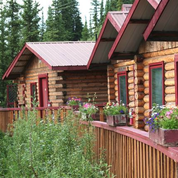 First Class Hotel Category (**** Hotels & Lodges) First Class hotels usually offer an additional amenities such as a restaurant, lounge, bar, fireplace seating, fitness room, swimming pool/hot tub, etc. All rooms in First Class hotels belong to a higher category and are always equipped with a private bathroom. Most hotels in this category are usually located in prime locations in prime downtown locations or in national parks. These include larger hotel chains such as: Marriott Hotels, Sheraton, Westmark Hotels, Princess Hotels and Lodges, Clarion Suites, Comfort Inn & Suite. The larger hotel chains are only available in Anchorage and Fairbanks. If a major hotel chain is not available, we prefer to book local premium hotels/deluxe cabins or cottages for our clients. Please note that premium accommodations may not be available in small towns; in such cases we will book the best available accommodation. 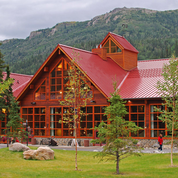 |
Rental CarWe’ve put together a selection of rental car categories designed specifically with Alaska travel in mind. Whether you’re planning a short getaway or a longer adventure, traveling solo or with a group, or working within a specific budget, you’ll find options that balance comfort, space, and practicality for the unique conditions of Alaska’s roads. From midsize cars for easy city driving to spacious SUVs and vans ideal for longer scenic routes or family trips, there’s a category for every type of journey. Not sure which vehicle is right for your plans? Simply reach out to us—we’ll be happy to recommend the rental car category that best matches your itinerary, group size, and travel style. Here are the car rental categories we offer: Mid Size Car (included - part of the package / additional day $150) Generally, midsize cars measure between 180 to 195 inches in length but can vary depending on specific models. Mid-size cars, also commonly known as intermediate or standard cars, are four-door sedans that are more spacious than compact cars while still being fuel-efficient. They can fit 3 or sometimes 4 bags depending on the model. They feature more interior space compared to compact cars and offer comfortable seating for four to five passengers.  Full Size Car (upgrade $12 per day / additional day $160) Full Size cars are what many people would describe as large cars. A full-size car typically refers to a vehicle that offers more extensive interior space, comfort, and power compared to smaller vehicles such as compact or midsize cars. These cars usually have larger dimensions, including length, width, and height. They commonly feature roomy interiors with ample seating for five or more passengers along with expanded trunk capacity for luggage or cargo. Historically, full-size cars were synonymous with large sedans boasting V8 engines and body-on-frame construction. While this has changed over time due to evolving industry trends and technological advancements, what remains consistent is the emphasis on spaciousness, comfort, and performance these vehicles provide.  Standard Size SUV (upgrade $88 per day / additional day $240) SUVs (short for sport or suburban utility vehicles) are good-sized vehicles with a rugged look, set higher off the road than normal cars. In an SUV, the description of “standard” generally refers to the size of the SUV. The standard SUV is larger than the intermediate or compact versions. These full-size models are more powerful, like a truck, and they are usually more equipped to handle a wider variety of terrains and road conditions as well. In addition to being powerful, their size also means that they typically have more seating capacity than the smaller SUVs. They can seat more passengers and have more cargo space for transporting luggage and equipment.  Standard Elite SUV (upgrade $105 per day / additional day $255) Perfect for families, groups, and adventurous travelers, the Standard Elite SUV delivers a spacious and comfortable ride with room for up to 7 passengers. These versatile SUVs combine strong performance with practical features, including automatic transmission and air conditioning, making them ideal for both city streets and Alaska’s rugged landscapes. Models in this category offer generous cargo space for luggage, gear, or supplies, ensuring every trip is smooth and stress-free. With their reliable handling, powerful engines, and family-friendly interiors, Standard Elite SUVs are built for travelers who want comfort, convenience, and confidence on the road. Book from this vehicle group to enjoy a safe, capable, and spacious SUV designed to make every journey a memorable adventure. 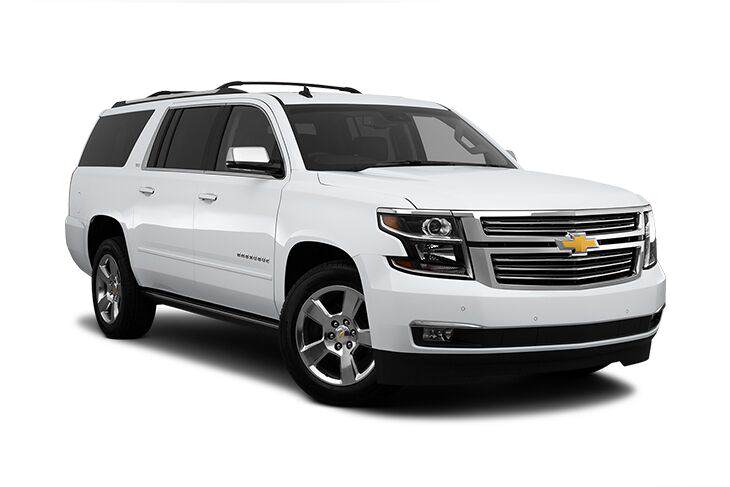 Mini Van (upgrade $125 per day / additional day $275) This roomy mini van is your ticket to family adventures and travel memories on your next rental. More spacious than a full-size car, and with better gas mileage than an SUV, a minivan is a 7-passenger van that provides unbeatable comfort and convenience. By providing leg and luggage room, configurable seating and storage layouts, easy in-and-out, competitive fuel efficiency, and high-performance drive—all without sacrificing style—minivans accommodate every kind of group outing, from lengthy family vacations to quick business trips. Did somebody say “road trip”?  11 Passenger Van (upgrade $250 per day / additional day $400) Choose a 11-person passenger van so that no one gets left behind on your road trip or vacation. Instead of trying to coordinate a car pool; save time, resources, and gas money by putting everyone together in one clean and comfortable van. You'll find each passenger has much more leg room. Sample Models: Chevrolet Express, Ford Transit or similar Sample Features: 3 Doors –10 to 11 Passengers- 6 Large Suitcases - Air-conditioning - Automatic Transmission 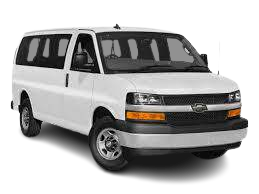 |
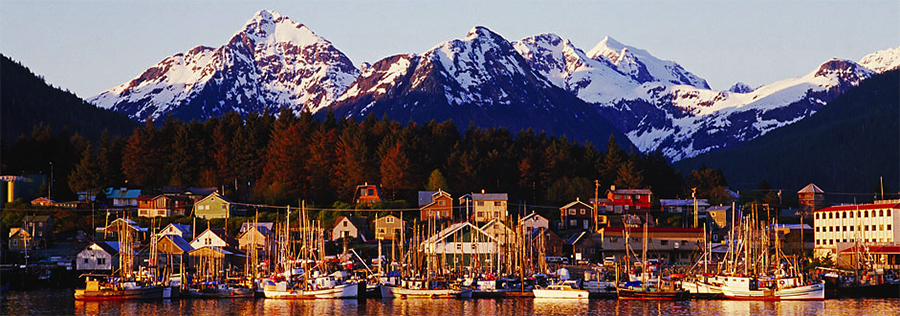 |
||||||||||||||||||||||||||||||||||||||||||||||||||||||||||||||||||||||||||||||||||||||||||||||||||||||||||||||||||||||||
Self Drive Tours Information - FAQ
|
||||||||||||||||||||||||||||||||||||||||||||||||||||||||||||||||||||||||||||||||||||||||||||||||||||||||||||||||||||||||
